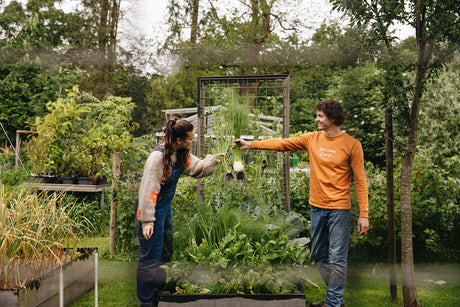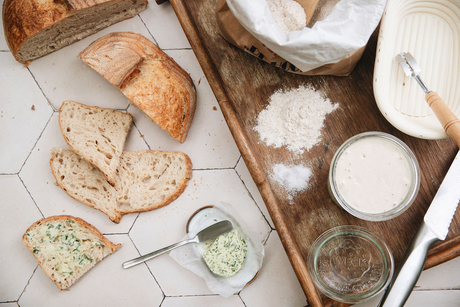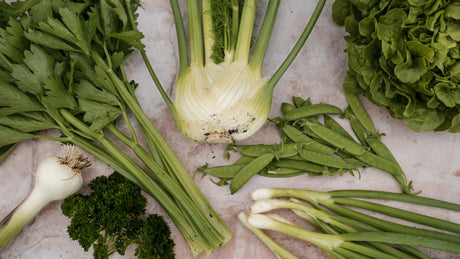Growing Stevia Yourself in 2 Ways | From Seeds or by Cuttings from Plants
Introduction: Growing Stevia as an Alternative to Conventional Sweeteners
There has been a lot of talk in recent years about the natural sweetener Stevia, also known as the honey plant. Stevia is a tropical perennial plant that is productive for about 4 to 5 years and that you grow for its sugary sweet leaves. The leaves are the perfect alternative to sugar in tea, jam, coffee and much more. Despite some specific cultivation properties, the plant is very easy to grow yourself in our regions. The perennial sugar bomb has a growth standstill in the fall and during the winter. You can grow the plant in two ways. You can grow the plant from seed, but you can also take cuttings from an existing plant and grow new small plants. This article highlights the two cultivation methods. Definitely worth trying.
Stevia is also very healthy, you will learn more about it later in this article. Be careful with purchased stevia in liquid form or in powder. Often there are chemicals in it for bleaching or preserving. Reasons enough to grow your own stevia.

Stevia
seeds , the darker the better
Growing Stevia from Seed
1. A long growing season so sow indoors
When growing this plant you need to take into account a long and warm growing season. Only then you can really harvest a lot of sweet leaves. It is therefore best to sow the
seeds indoors in light intensive, warm and humid conditions for the
seeds to germinate.
2. Sow in seed and cutting soil with perlite
In the
tray with 51 holes, it is best to put a mix of 2/3 sowing and cutting soil and 1/3
perlite . If you do not have
perlite , you can also use pure sowing soil. Fill the
trays until your
tray is 1 cm from the top. Moisten the mix well before sowing, the excess water can drain from the
tray through the drainage holes at the bottom of each cell. Sow 2
stevia seeds in each cell. Press the seeds well and cover your soil with a layer of
perlite . This way the
seeds are well protected from air but not from light. Spray the top layer
of perlite well with a
plant sprayer .
A heated
propagator with
grow lights is not an unnecessary luxury. The
seeds germinate optimally at 22°C under humid conditions. The slides of the
propagator can therefore be closed or if you do not have
a propagator , you can stretch a cellophane over your
seed tray and remove it as soon as you see germination.

Stevia seedlings
3. When growing Stevia, your seedbed should never dry out.
Water your
seeds twice a day to prevent the
seeds from drying out. Drainage holes are essential to prevent rot. No water should remain in the
trays or
seed trays . Water when the top centimetre is moist. Use a
plant sprayer on a fine setting to water, certainly do not water from a
watering can otherwise you will move your germinating
seeds and interrupt the germination process.
4. Transplanting your germinating stevia seeds and seedlings
The first signs of germination occur after 10 to 15 days, depending on the conditions. When two
stevia seeds germinate per cell, you can thin one out. Keep the strongest seedling and remove the weakest. When your stevia plants are 5 cm tall, you can transplant them to P7 pots where they can continue to grow in
potting soil for vegetable gardens for another 2 months. I use a spoon to scoop out the seed
trays . In a
seed tray, you can also use a soup spoon to loosen the plant.
Plant your stevia plants out when they already have a lot of real leaves and when the risk of frost has passed. The end of May is an ideal time. Choose a sunny spot for your planting, short periods of shade are also allowed. Plant your plants 25 to 50 cm apart in soil rich in
compost and organic material. You can also work in a handful
of organic fertilizer pellets for vegetable gardens.
So now your stevia plants are planted out. Further in the article you can read how to grow them from cuttings, how to care for them, all about harvesting and some tips for using stevia in the kitchen. But first a bit more about the
stevia plant .

Stevia mature plants
6. More about the plant stevia
Stevia is a tropical plant that stops growing during the fall and winter. That is why this plant is considered a perennial plant that you can grow for four or five years.
During spring, new shoots will shoot out, which will grow from under the root. From spring to mid-August, the plant will produce new cuttings, similar to geranium cuttings. However, it is better not to transplant new shoots that are in bloom, because these shoots will never
root . The flowers on these shoots will also never produce seeds that can germinate. New plants can only be produced by cutting the plant.
7. Stevia is very healthy for your body
Stevia offers multiple medicinal properties. The sweetener is a powerful weapon against high blood sugar, high blood pressure and various digestive problems. In addition, it is said that stevia can also offer a solution for people who suffer from anxiety and serious conditions, such as obesity.

When you grow your own stevia at home, you can be sure that the end product is of the highest quality and that no harmful chemicals were used during the growing process. In this article, we will explain how to do this.
8. How to Grow Stevia at Home from Cuttings

growing stevia
You can perfectly grow stevia yourself in your own garden. To be able to do this successfully, it is important that you adhere to a number of plant and care guidelines. The correct way to harvest the leaves is also an important success factor.
9. What do you need to grow stevia from cuttings?
- A stevia plant (can also be ordered in our webshop during the season)
- 1 large pot (2 to 4 liter pots are very good)
- The last four inches of a stevia plant shoot (make sure there are no flowers on it)
- Peat moss (enough to fill the pot)
- Water to water the plant
Step 1 - Fill your jar
Fill the pot with peat moss. This soil can usually be purchased at garden centres. Moisten the moss well with water.

Stevia cuttings
Step 2 - Preparing the stevia cuttings
Remove two or three leaves from the bottom of the shoot to facilitate transplanting. Bury the bottom of the shoot completely and make sure to press the moss lightly with your fingers so that the shoot comes into contact with it. It is better not to wait too long before planting the shoot after cutting it.
Step 3 - Putting away your pot or pots
Place the pot in a place with a lot of shade. Try to avoid direct sunlight. Water the shoot three times a day to ensure that the moss is moist enough.

Stevia cuttings in a pot
Step 4 - Wait for your stevia cutting to root
If all goes well, you will see after a month that the shoot is standing upright. As soon as new leaves shoot out, you can move the pot to a slightly sunnier spot, so that the plant will continue to grow.
Step 5 - Planting out or moving to the garden
Some tips for planting out or moving your
pots outside:
- When transplanting the plant into the garden, start by removing the new leaves.
- When the plant is in the garden, you only need to water it once a day.
- During the warm summer days, you can water the plant every day. During spring and autumn, you better check first if the moss is moist before watering the plant.
- During the winter, only water the plant when the moss is dry. If the moss is too moist, the roots will rot.

Stevia in bloom must be harvested
Step 6 - Harvest Stevia as needed for consumption and prune completely in late fall
You can harvest leaves to process during the year. Towards the end of autumn, when the plant is in full bloom and has stopped growing, you should prune the plant until it is only ten centimetres high. At temperatures below -5°C you should put up
fleece or, if you are growing in
pots , bring them inside
Step 7 - Drying your stevia leaves or branches after harvesting
First wash your pruned branches or harvested leaves. Dry the harvested leaves or branches in a towel or on kitchen paper. In the case of the branches, pick the leaves from the branches. To dry stevia leaves, it is best not to expose them to direct sunlight. This way they retain all their good properties. You can dry the leaves indoors. The temperature in the house is usually good here. After a few days the leaves are dry, in a dehydrator it goes faster of course, in 8 hours your leaves are dried and ready to grind. Grind the dried leaves in a coffee grinder or blender and enjoy!

10. Medicinal uses of stevia
Studies show that stevia is very healthy for people with type 2 diabetes. Consuming stevia can help control excess glucose in the blood and at the same time soothe discomfort associated with the digestive tract and the cardiovascular system.
People who are obese can burn fat faster and easier by consuming stevia. In addition, stevia has diuretic properties, which makes it a great tool for cleansing the kidneys and flushing out excess fluid from the body.
11. A healthy Stevia infusion

Stevia infusion tea
We recommend eating four soft leaves before or during breakfast and another four leaves during dinner. You can make an infusion of dried leaves. It is best to make this infusion fresh each time you want to drink it. You can also make a little more infusion at once and then store it for a maximum of two days.
Ingredients
- 2 tablespoons dried, crushed stevia leaves (20 grams)
- 1 liter of water
Instructions
- Bring the water to a boil. Once the water is boiling, remove the pan from the heat and add the two tablespoons of dried stevia.
- Let the stevia steep for at least thirty minutes before drinking the infusion. Thirty minutes is enough to ensure that the properties of the stevia end up in the water.
- Strain the infusion and drink one cup a day.
So get started and grow your own stevia at home. This will undoubtedly be a very pleasant experience. Moreover, you will grow a great ally for your body and your health.
 Stevia seeds , the darker the better
Stevia seeds , the darker the better Stevia seedlings
Stevia seedlings stevia plant you
stevia plant you Stevia mature plants
Stevia mature plants When you grow your own stevia at home, you can be sure that the end product is of the highest quality and that no harmful chemicals were used during the growing process. In this article, we will explain how to do this.
When you grow your own stevia at home, you can be sure that the end product is of the highest quality and that no harmful chemicals were used during the growing process. In this article, we will explain how to do this.
 growing stevia
growing stevia Stevia cuttings
Stevia cuttings Stevia cuttings in a pot
Stevia cuttings in a pot Stevia in bloom must be harvested
Stevia in bloom must be harvested
 Stevia infusion tea
Stevia infusion tea






